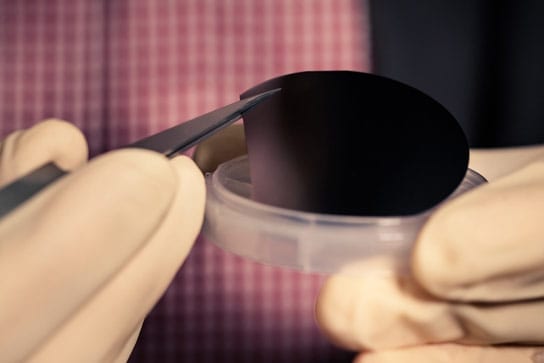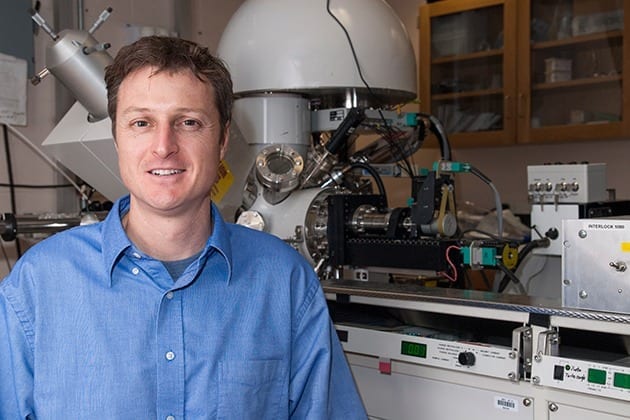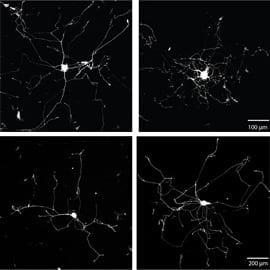
Based on the photon-enhanced thermionic emission (PETE) process, a new solar-energy device is about 100 times more efficient than its previous design.
Scientists working at the Stanford Institute for Materials and Energy Sciences (SIMES) have improved an innovative solar-energy device to be about 100 times more efficient than its previous design in converting the sun’s light and heat into electricity.
“This is a major step toward making practical devices based on our technique for harnessing both the light and heat energy provided by the sun,” said Nicholas Melosh, associate professor of materials science and engineering at Stanford and a researcher with SIMES, a joint SLAC/Stanford institute.
The new device is based on the photon-enhanced thermionic emission (PETE) process first demonstrated in 2010 by a group led by Melosh and SIMES colleague Zhi-Xun Shen, who is SLAC’s advisor for science and technology. In a report last week in Nature Communications, the group described how they improved the device’s efficiency from a few hundredths of a percent to nearly 2 percent, and said they expect to achieve at least another 10-fold gain in the future.
Conventional photovoltaic cells use a portion of the sun’s spectrum of wavelengths to generate electricity. But PETE uses a special semiconductor chip to make electricity by using the entire spectrum of sunlight, including wavelengths that generate heat. In fact, the efficiency of thermionic emission improves dramatically at high temperatures, so adding PETE to utility-scale concentrating solar power plants, such as multi-megawatt power tower and parabolic trough projects in California’s Mojave Desert, may increase their electrical output by 50 percent. Those systems use mirrors to focus sunlight into superbright, blazingly hot regions that boil water into steam, which then spins an electrical generator.
“When placed where the sunlight is focused, our PETE chips produce electricity directly; and the hotter it is, the more electricity it will make,” Melosh said.
The heart of the improved PETE chip is a sandwich of two semiconductor layers: One is optimized to absorb sunlight and create long-lived free electrons, while the other is designed to emit those electrons from the device so they can be collected as an electrical current. A cesium oxide coating on the second layer eases the electrons’ passage from the chip. Future research is aimed at making the device up to an additional 10 times more efficient by developing new coatings or surface treatments that will preserve the atomic arrangement of the second layer’s outer surface at the high temperatures it will encounter in the concentrating solar power plant.
“We expect that other materials, such as those incorporating barium or strontium, will make the surface much more stable up to at least 500 degrees Celsius,” said Jared Schwede, a Stanford graduate student who performed many of the PETE experiments. (play video to see Schwede explain the PETE technology)
The Latest Bing News on:
Solar Energy Device
- Smelting Steel With Sunlight: New Solar Trap Tech Could Help Decarbonize Industrial Heaton May 17, 2024 at 7:46 am
The solar trap can efficiently generate temperatures of over 1,000 degrees Celsius—hot enough for a host of carbon-intensive industries.
- Solar incentives by stateon May 17, 2024 at 4:22 am
Depending on where you live, you may be eligible for additional solar incentives, such as tax breaks and rebates. Overall, New York and Oregon have the most state-funded solar incentive programs.
- Smelting Steel Without Fossil Fuels: Solar Power Shatters the 1,000°C Barrier for Industrial Heatingon May 17, 2024 at 1:14 am
Swiss researchers have developed a solar energy method using synthetic quartz to achieve temperatures above 1,000°C for industrial processes, potentially replacing fossil fuels in the production of ...
- Using solar heat to revolutionise steel and cement manufacturingon May 16, 2024 at 5:06 am
Researchers in Switzerland are introducing a method to use solar energy instead of fossil fuels to generate the high temperatures required for smelting steel and producing cement ...
- Breakthrough solar power technology could replace fossil fuels in heavy manufacturingon May 15, 2024 at 5:04 pm
A potentially groundbreaking solar-powered device has achieved temperatures over 1,000C, raising hopes for using green energy to run some of the most fossil fuel-intensive manufacturing processes on ...
- Solar energy is being trapped in crystals to reach absurdly hot temperatureson May 15, 2024 at 11:02 am
Engineers are cooking up a new clean energy solution: charging up crystals with solar energy to temperatures of 1,832 degrees Fahrenheit (1,000 degrees Celsius), potentially making them a greener ...
- Scientists achieve over 1,000 degrees Celsius with solar power alone rather than fossil fuels. A game changer for heavy industries?on May 15, 2024 at 10:56 am
When you hear about solar energy, you immediately think of blue panels and clean electricity. However, electricity is just one type of energy. The sun’s energy also provides heat, which helps to keep ...
- Scientists generate heat over 1,000 degrees Celsius with solar power instead of fossil fuelon May 15, 2024 at 10:30 am
Instead of burning fossil fuels to smelt steel and cook cement, researchers in Switzerland want to use heat from the sun. The proof-of-concept study uses synthetic quartz to trap solar energy at ...
- Are solar panels worth it? The cost and environmental benefits of going solaron May 15, 2024 at 9:04 am
Are solar panels worth it? Find out what you can expect to pay and how much you’ll save so you can decide if solar is right for your home.
- Sunlight-trapping device can generate temperatures over 1000°Con May 15, 2024 at 8:00 am
A solar energy absorber that uses quartz to trap heat reached 1050°C in tests and could offer a way to decarbonise the production of steel and cement ...
The Latest Google Headlines on:
Solar Energy Device
[google_news title=”” keyword=”Solar Energy Device” num_posts=”10″ blurb_length=”0″ show_thumb=”left”] [/vc_column_text]The Latest Bing News on:
Photon-enhanced thermionic emission
- Google unveils overhauled search with AI-enhanced results. Here's what to knowon May 14, 2024 at 5:00 pm
Google began testing AI overviews with a small subset of selected users a year ago, but the company is now making it one of the staples in its search results in the U.S. before introducing the ...
- Airborne single-photon lidar system achieves high-resolution 3D imagingon April 24, 2024 at 5:00 pm
The new airborne single-photon lidar system works by sending light pulses from a laser toward the ground. These pulses bounce off objects and are then captured by very sensitive detectors called ...
- Demonstration of heralded three-photon entanglement on a photonic chipon April 24, 2024 at 5:00 pm
More information: Si Chen et al, Heralded Three-Photon Entanglement from a Single-Photon Source on a Photonic Chip, Physical Review Letters (2024). DOI: 10.1103/PhysRevLett.132.130603.
- Tesla cuts FSD price, ditches Enhanced Autopiloton April 22, 2024 at 7:18 am
Shortly after reducing the price of its cars in the U.S., Tesla has now dramatically reduced the price for the Full Self-Driving (FSD) package. The price for FSD on all variants of Tesla vehicles ...
- How to enable Enhanced Search Mode in Windows 11/10on December 31, 2023 at 3:34 pm
Microsoft has included an Enhanced Search Mode in Windows 11 and Windows 10. Compared to the Classic Mode, Enhanced search mode indexes everything on your Windows PC. In this post, we will share ...
- Versatile Tungsten Thermionic Emission SEM System - VEGA4on August 12, 2023 at 7:24 pm
Let us help you with your inquiries, brochures and pricing requirements Request A Quote Download PDF Copy Request A Quote Download PDF Copy Request A Quote Download ...
- Solar Thermal/Thermionic Energy Converterson August 8, 2023 at 6:08 pm
Solar thermal technology [1], is promising for both small and utility scale renewable energy systems and solar thermionics [2] is an emerging technology where solar energy heats a metal such that ...
- How to enable Hyper-V Enhanced Session in Windows 11on February 26, 2023 at 4:00 pm
To learn more about these steps, continue reading. To get started, you need to enable the Enhanced Session mode for the specific virtual machine. For that, open the Hyper-V app first on your ...
- Emission spectraon July 25, 2020 at 9:11 pm
If an electron is in an excited state it can return to a lower energy level. When it does this, it loses energy. The amount of energy it loses will be equal to the difference in the energy levels ...
- Solar technologieson May 7, 2019 at 9:21 pm
We specialise in Photovoltaic Technology based on Earth Abundant Materials (PVTEAM) & Energy and the physical sciences: Beta-enhanced thermionic energy converters and nuclear batteries employing ...
The Latest Google Headlines on:
Photon-enhanced thermionic emission
[google_news title=”” keyword=”photon-enhanced thermionic emission” num_posts=”10″ blurb_length=”0″ show_thumb=”left”]











